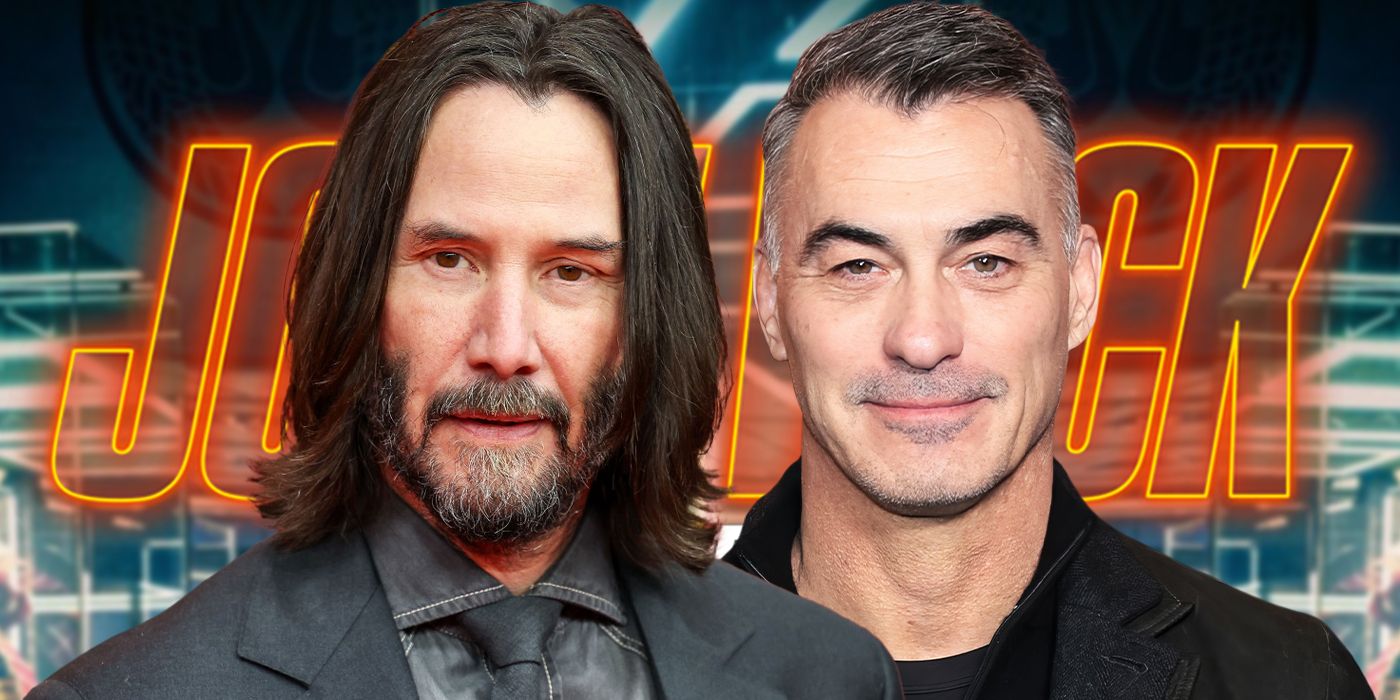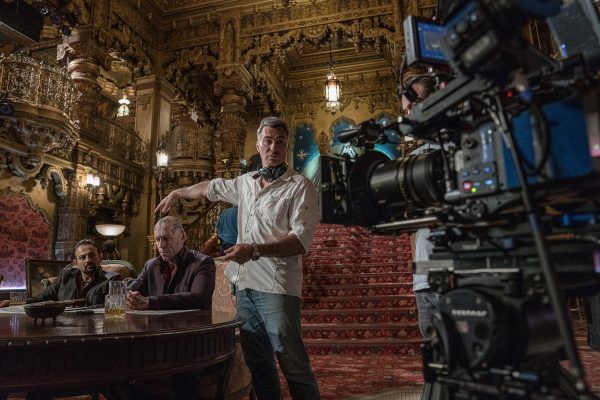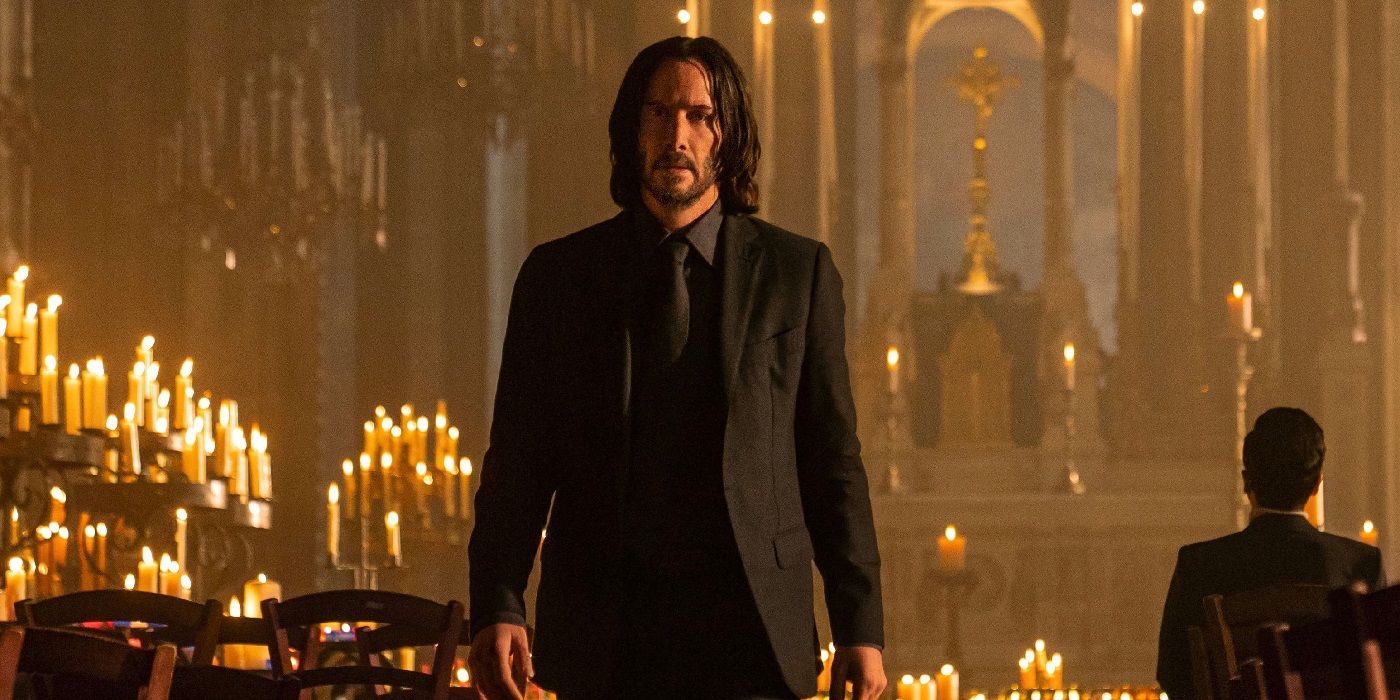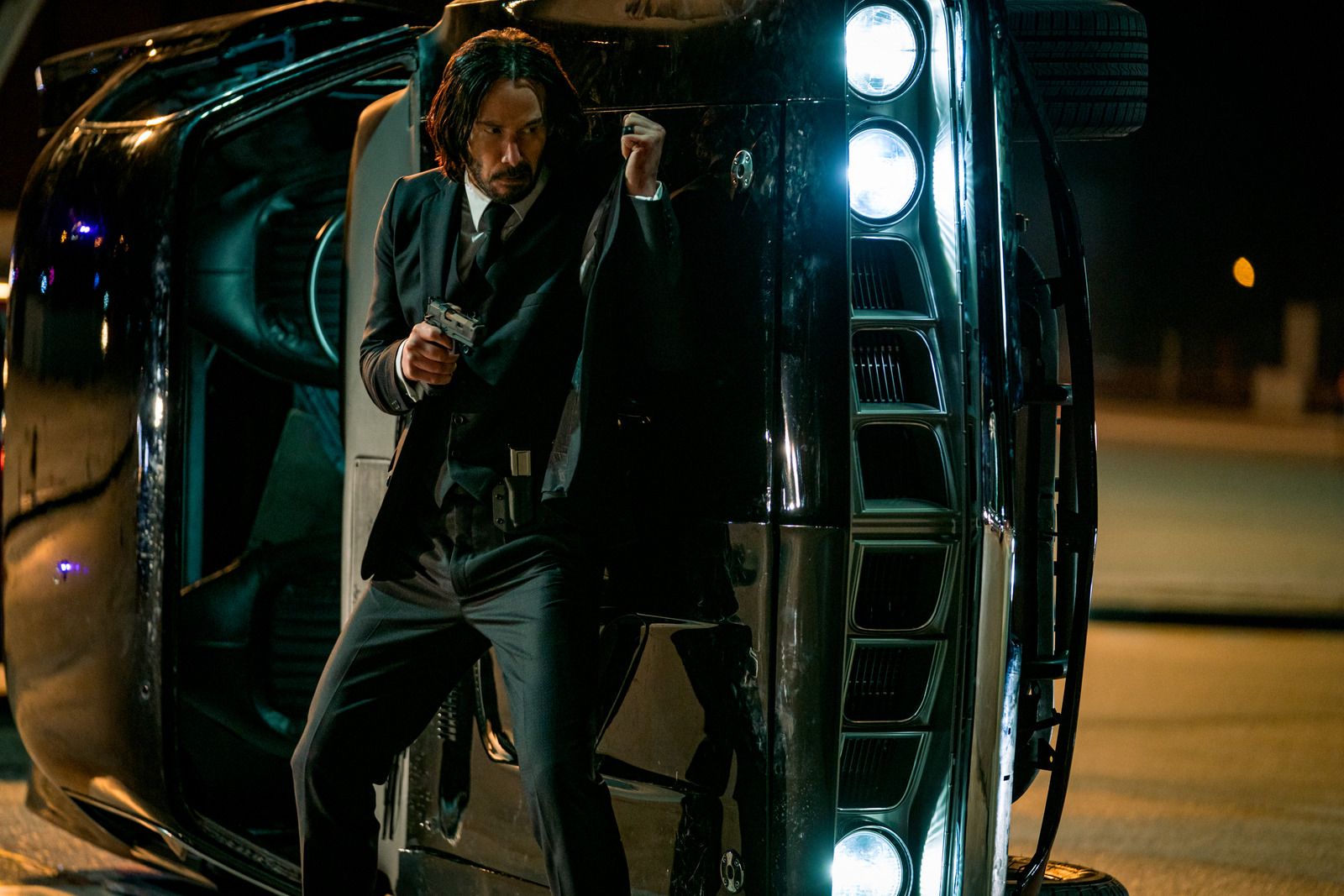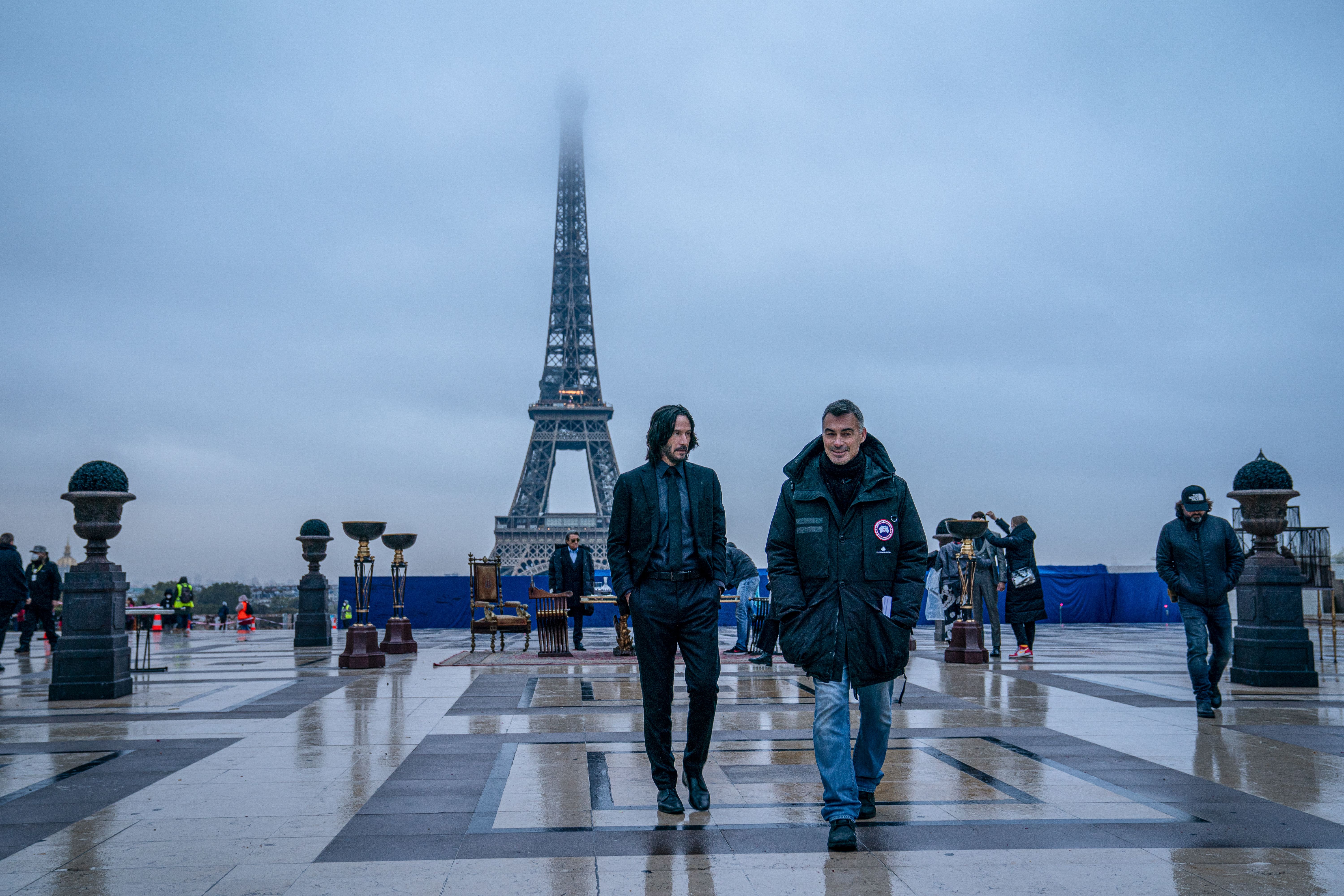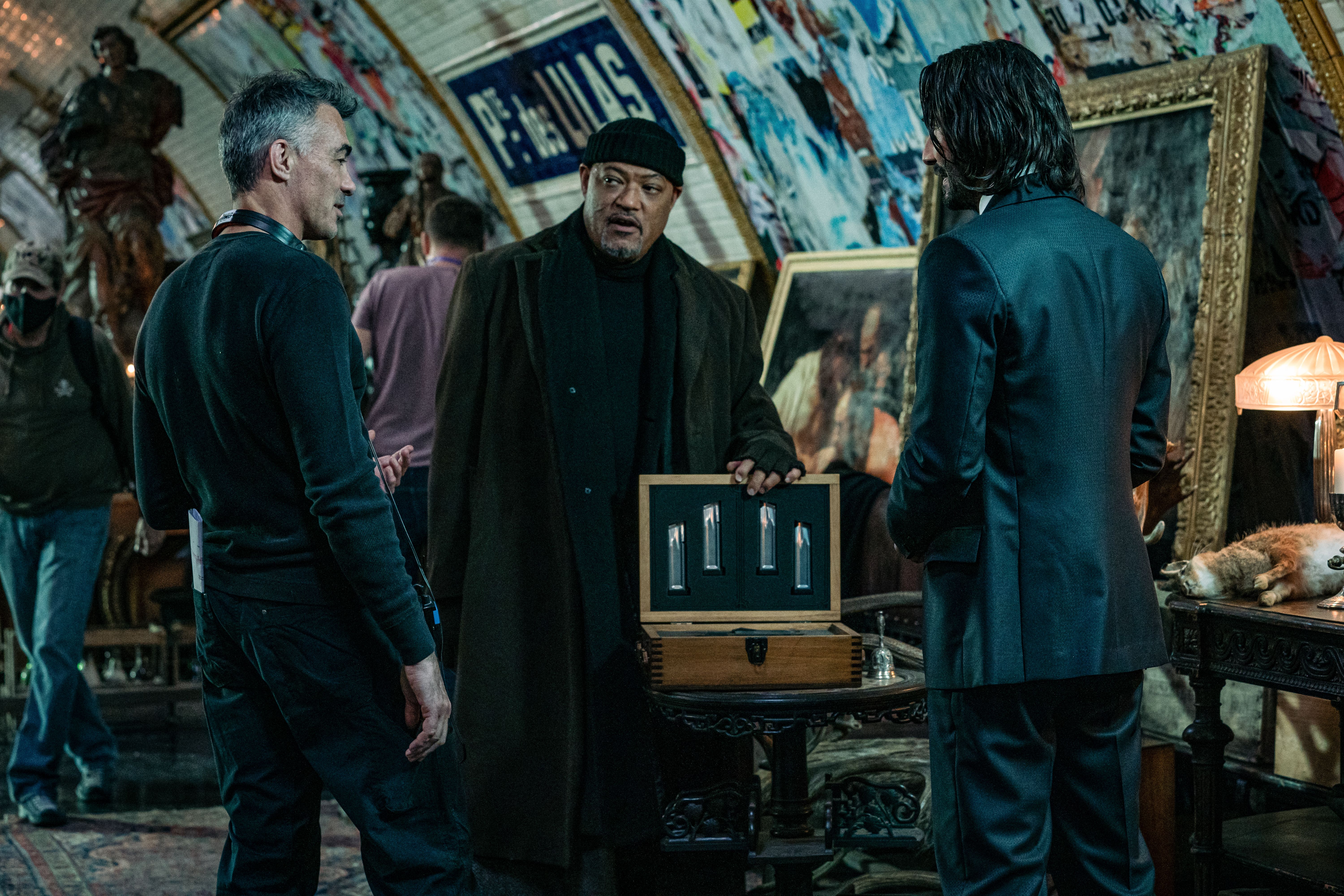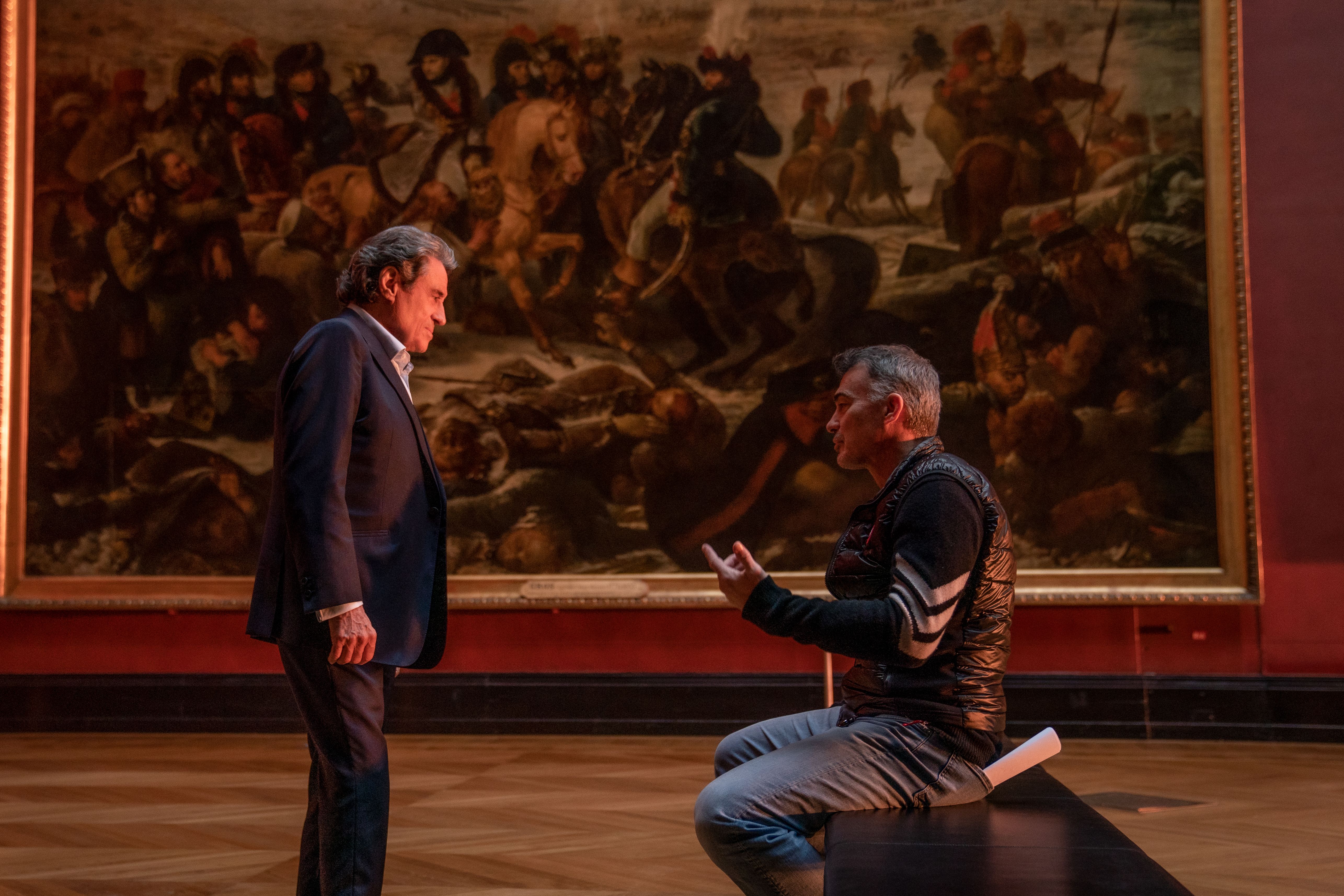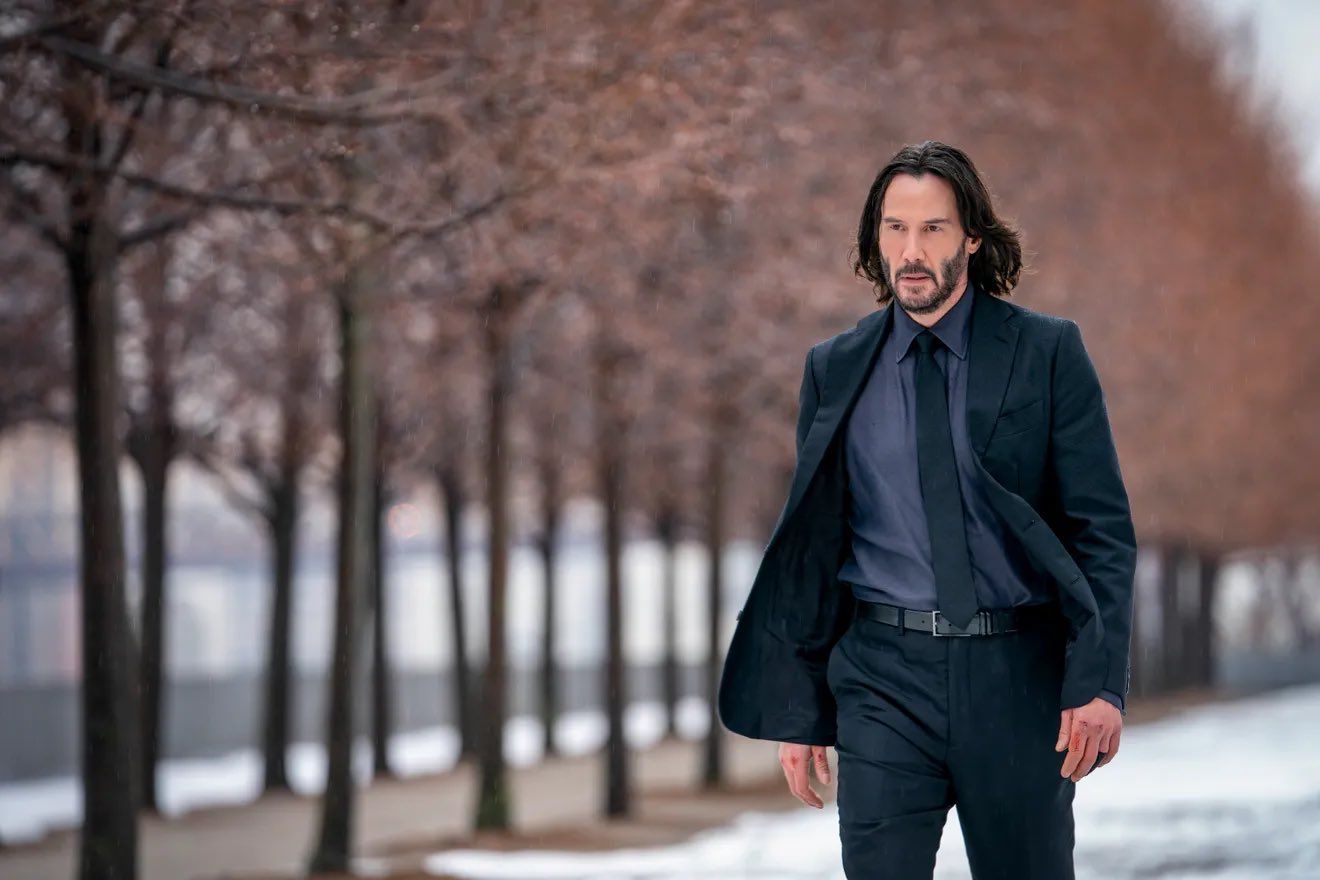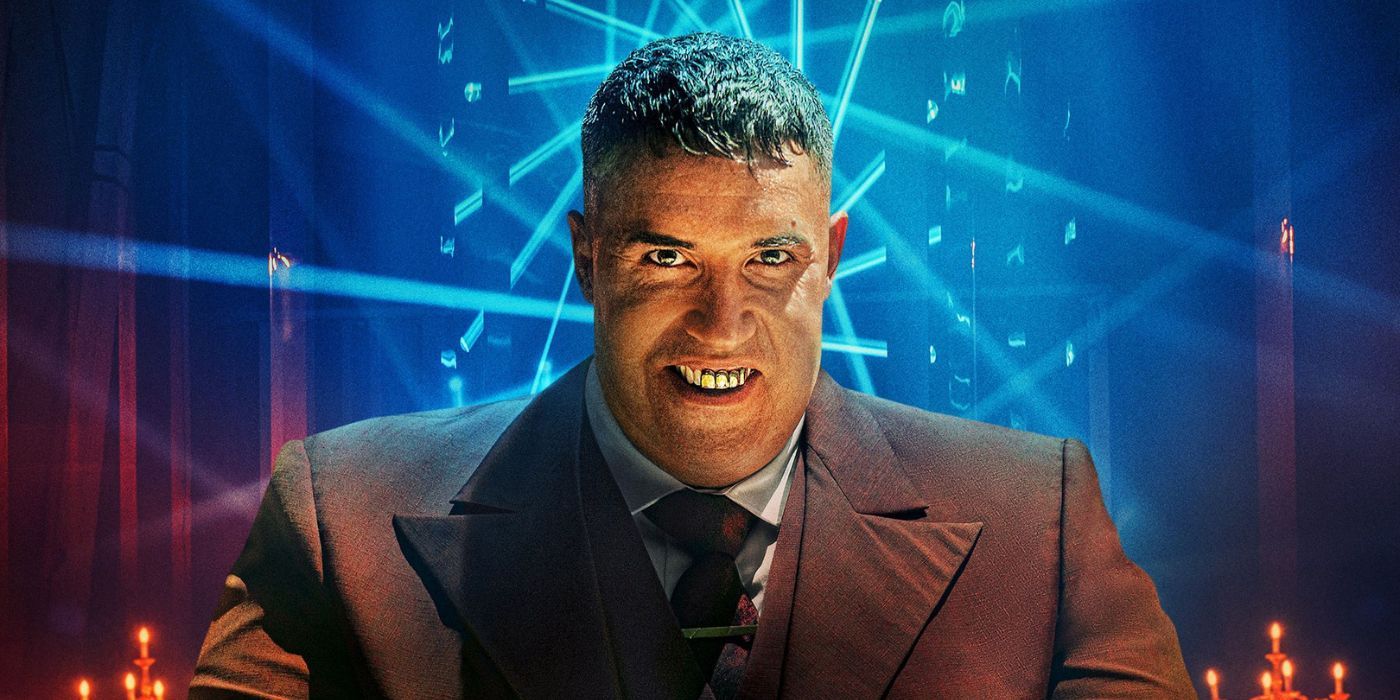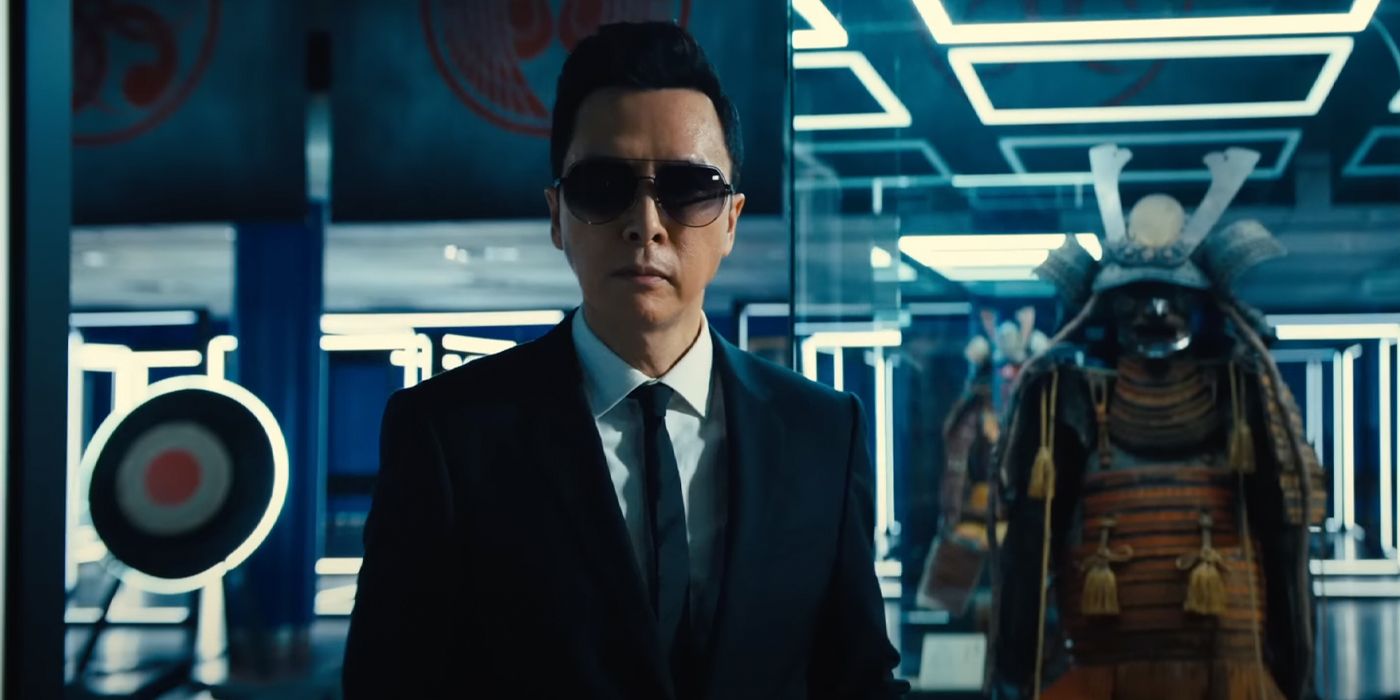Editor's note: The following contains spoilers for John Wick: Chapter 4.
If you’re a fan of the John Wick franchise and are curious about how Keanu Reeves and director Chad Stahelski pulled off the jaw dropping stunts in John Wick: Chapter 4, then you’re in the right place.
A few nights ago, Collider and IMAX teamed up for an early screening of the sequel in Los Angeles and after the film ended, I sat down with Reeves and Stahelski. During the wide-ranging interview, they discussed what the hardest stunts were to film in the franchise, how they filmed the incredible oner in the Parisian building where Reeves is walking around with the dragon’s breath shotgun with the camera above him, the challenges of filming at the Arc de Triomphe with cars, that stair sequence at Sacré Coeur, and why all of the choreography went out the window during the first fight scene with Donnie Yen.
In addition, they explained why they always come up with the next sequel ideas while drinking whiskey at the Imperial Hotel in Tokyo, which of the films changed the most in the editing room, what went into the incredible Berlin club sequence with Scott Adkins in Chapter 4, how Reeves preps for his stunts, and so much more. If you’re a fan of this amazing franchise, then you’re going to learn a lot. While you can either read or watch the interview, I’m going to strongly recommend pushing play on the video for this one. In one part of the video, you’ll see Reeves walk around demonstrating something—and it’s just not the same as reading it.
Finally, due to how many movies are coming out this month and next, John Wick: Chapter 4 is only playing in IMAX theaters for one week. So, if you want to see the movie on the best screen possible, I’d make an effort to catch it this weekend or early next week.
COLLIDER: All right, you guys have put on screen some incredible action set pieces, and I am curious, with the four films, what do you think were the top three in terms of the difficulty from staging, filming, everything that went into a training? What were the top three?
CHAD STAHELSKI: Arc de Triomphe? That was pretty hard, a lot of cars, dog, stuntmen. Halle Berry, number three, dogs, a lot of dogs, a lot of crotches.
KEANU REEVES: What about, I mean, even like the first one because we didn't know what the heck we were doing. Like the home invasion–
STAHELSKI: That was pretty rough.
REEVES: I mean, it wasn't rough, rough, but I mean, yeah, let's go to the club.
STAHELSKI: Keanu had a fever that day.
REEVES: But I mean, you might have known it was gonna happen, but I certainly didn't know.
STAHELSKI: Yeah, probably. We kept that from you. We didn't want to tell you too much. But, yeah, probably the nightclub, first movie, was pretty good.
REEVES: Just because it was so new.
STAHELSKI: Yeah, we were clueless.
REEVES: And then, what about the party scene fight in Rome on 2?
STAHELSKI: I forgot about the rock concert.
REEVES: Yeah, the rock concert fight. That was pretty fucking awesome. What about 3? Horses? Riding horses, getting off of horses…
STAHELSKI: I’m gonna put that as number two, the horses in Brooklyn. Brooklyn does not like horses.
REEVES: Sorry, we’re taking all the time by answering Steve’s question here.
STAHELSKI: No, we forgot that we had trains. So we had to do a horse chase under trains. Horses don't like trains.
REEVES: No.
STAHELSKI: So every 20 minutes the train would come by and the horses would have to take off.
REEVES: Yeah, but people think it's just me riding. It's like this whole rig with a guy actually looking backwards, there were wires, the horse went crazy, I fell off and got buried into the back.
STAHELSKI: Yeah, it wasn't very John Wayne.
I like how it basically goes through every movie. You're just mentioning every set piece and being like, “That was impossible. Oh, that was impossible.”
STAHELSKI: We keep trying to get better, but sometimes it doesn't work out that way.
So Chad told me that the way you guys come up with the next installment is at the Imperial Hotel in Tokyo over whiskey.
REEVES: That's happened a couple of times.
Right, so could you sort of pull back the curtain on that? Is it literally you guys at the bar drinking a certain kind of whiskey and just shooting the shit?
REEVES: Well, what happens is, the film gets released in Japan usually a few months after the States, and so we've known what the reaction from the American audience is. And I guess the studio, Lionsgate, has a perspective on whether they want to make another one or not. And so, it's usually in Japan where it's either like, “Oh, they said we can do another one,” and then we look at each other and go, “Well, what do you wanna do?”
STAHELSKI: “I don't know.”
REEVES: And then we just make shit up. We usually come out of Japan with at least one or two ideas.
STAHELSKI: Always one good one.
REEVES: One or two ideas.
STAHELSKI: That's the whiskey.
Can I ask, what is the whiskey of choice for each of you?
STAHELSKI: Yamazaki, Hibiki 21, probably something like that.
Hibiki 21 is quite good, and also impossible to get.
STAHELSKI: Not in Japan.
REEVES: Yeah, so for this one, the idea was– you know, because we have to come up with a “why,” right? What's the “why,” why make it? And, after Chapter 1, well, just after John Wick, it was like, the why? Well, he's on the run, but even before on the run, maybe let's open up the world. And it was like the marker and all of the friendships–
STAHELSKI: The High Table.
REEVES: And then Chapter 4 was, “Why make it?” And it was like, “OK, he has to die.” That would seem like the only reason to make it, you know what I mean? Like, it's impossible. He can't survive the High Table. I mean, you keep fighting… That's the whiskey talking?
STAHELSKI: [Laughs] Not yet. Wait ‘til Monday.
I'm curious for Chad, which of the four films changed the most in the editing room in ways you didn't expect?
STAHELSKI: Good question. I would say probably number three. Number three, we kind of shifted the second act around a little bit. Funny enough, I think, obviously there's a lot of work to be done. You, you try to really find the way to the story. Like I on number four, as you guys just watched, we tried to do a lot of different characters and a lot of different storylines all converging on John's storyline. Number four is most like the script, I think, of all the movies. I think it's the truest to the script as far as editorial goes.
I'm trying to think. Number two, its end of second act, and number three, we had to find a little bit with all the montage stuff. But I think number three was where we shifted story a little bit more in editing to really streamline it. I think number three, we're just under two hours on that one. So, I think that was probably the most streamlined one we had.
So this film is two hours and forty minutes, plus credits, let's say something like that. How long was your director's cut on this one?
STAHELSKI: Oh, three [hours and] forty-five, easy. No credits, like right on.
When you say the director's cut, you mean like that's an assembly cut, or that's a cut that you actually thought about showing?
STAHELSKI: No, that's what we showed the studio. Yeah, that was funny.
REEVES: How Not to Get the Studio on Your Side, by Chad Stahelski.
STAHELSKI: Go to Chad Stahelski film school. But I think there's probably like 15 minutes just for enjoyment for me, I'd probably put back in. It was more world-building. But I think the movie we released is absolutely the best version of everything we've tried, and we tried all kinds of different stuff just to proof check it. I think this is the best version, but there are cool little scenes that just didn't make it. With Keanu in Berlin, he finds guns. That's why there's this whole Berlin part, and there's a lot more club fight, there's a lot more Arc de Triomphe, a lot more.
Obviously, we're talking about the theatrical release in IMAX theaters and in movie theaters, but is there a chance the Blu-ray would have some of these scenes?
STAHELSKI: I don't know, I think there are some pretty funny scenes I think that we did that will probably get released at some point. I don't know if it'll be part of another cut, but I don't know, we'll see how we do on Monday.
This is for both of you, when you're doing an action scene with people fighting, generally, there are no extras because you can control the environment. And in this film, you decided to do a Berlin Club scene that involved people, music lights, rain, Scott Adkins being amazing and just basically making an impossible scene. So who was like, “This is what we're gonna do.”?
REEVES: [Gestures to Stahelski]
STAHELSKI: Yeah.
REEVES: I mean, you met with the production designer. That was almost a post-whiskey idea of like, “I want there to be water in a club scene.”
STAHELSKI: Really, my dad's a plumber, so I grew up with all these water fixtures growing up, and he had this waterfall feature in the house that we had worked on when I was like 14. I was like, “I'm gonna use that in a movie,” and we just put 40 of them in instead of just one.
REEVES: 45,000 gallons a minute.
STAHELSKI: 45,000 gallons of water a minute in that club.
REEVES: We sank.
STAHELSKI: Yeah. But about the extras, when you do martial arts choreography, you're always trying to create the maze. What's the set piece? You watch Jackie Chan, or any of the Great Hong Kong guys do it, and there's always a maze, you know? They're going through hallways, they’re going through things, there's always an obstacle. So, you've seen us do it with glass, with mirror rooms, and then in the club we do it with people. You know, moveable walls, which is what we call background extras. It takes a lot of time. It takes a lot more coordination. But there are about 20 or 30 of them that are all professional dancers that were always surrounding Keanu and the cast.
And then we took that idea of movable walls and we just went, “Well, we did it with people, let's do it with cars,” and that's how we did it with the Arc de Triomphe.
Well, I wanna ask you, Keanu, if you don't mind, filming that Berlin club – I could be wrong, but I think this is the first time I've seen you doing action with that many extras behind you and around you. What is that actually like as a performer, knowing you have all these people and, and resetting it, it takes, I don't know, 10, 20 minutes, or whatever it might be?
REEVES: You kind of start working that out when the camera sets up. So when you start moving with the steady cam operator, and you start filling in all the extras, they get familiar with what's going to happen. And then, if you have to go through people, Chad usually puts in some stunt people that you can shove away and stuff.
STAHELSKI: Blockers, we always had a couple of blockers.
REEVES: Yeah, just like, “Hi, I’m just dancing…” and John Wick hits you in the face. So it's really they get to know the situation, get acclimatized, everyone kind of gets through the repetition of it.
STAHELSKI: Yeah, a lot of rehearsals. I mean, the way we do the martial art choreography, the way our stunt guys train, is mostly like dancers anyways, all based on memory and motion, and group dance or group performance. So when we get together with, you know, I got my 30 stunt guys plus 30 of the dance people, they all kind of work well together, and then we just build the extras out in sections of 50. So you can train them, and then put them in, and you realize who's good, who's not, who's got the right look, who doesn't. You kind of partition them off to be in different sequences. It does take time, but I think the effect is very cool.
So can I ask how long does a sequence like that take you to actually film.
STAHELSKI: In the, in the club with the upstairs? I think, I wanna say probably nine days total, I think nine to ten days for all of, for the upstairs gambling and the, and the club sequence.
And how long before you step on set? Are you training for that? Practicing for that? All the extras are practicing and how much is all being figured out right there on set?
STAHELSKI: Keanu and the stunt guys have rehearsed the same.
REEVES: Yeah. So when they were filming Hiroki and, and Donny Yen scene when they're having their showdown in the Osaka Continental in the beginning of the film, I was in another room where we were filming in Berlin just training and learning choreography, because my fight scene was up after that. And then for the club stuff. Yeah, so I was training during the weekends because there was a lot of, there were some dog hits that aren't in the movie. So I was training dog hits, getting hit by the dog and pulled by the dog. Yeah, so it's like a mix. There's like stuff that's known, training for what's known and then make it up. I don't know, I guess for my interactions that are in the movie, that's pretty much all set choreography.
I definitely want to talk about, you have an incredible oner. Does everyone in this room know what a oner is or actually let's, we should explain what a oner is for people that don't know, but you have the oner scene where you lift the camera up and it's going over everything and you're using the dragon's breath shotgun. It is just awesome. Can you sort of talk about filming that and why you wanted to do a oner? And Keanu can you talk a little bit about the dragon's breath shotgun?
STAHELSKI: It's pretty awesome. I think we just knew as we were designing the sequence, we wanted to ramp up like in the third act. So it goes from one set piece to another set, obviously Arc de Triomphe, the driving to the apartment building with the dragon's breath, the top shot. And then of course, we want to end with the Buster Keaton staircase idea. So we needed something to kind of all the gun-fu that we had been doing. And we just thought, well, we trade off so much with the video game world and we, we like so much of like Asian cinema, so we wanna do a top shot. But it was, you know, most people don't do the top shots because you just look down at the floor and there's not a whole lot there it's a black carpet or something.
So we started talking to the production designers and Dan and the cinematographer about how do we make this interesting, how to make it fun? And then we were doing our rabbit hole dive on all our weaponry and martial art choreography and we forgot that we were gonna use the dragon's breath somewhere else in the movie. But like we saw that, you know, from a top view, it had that beautiful muzzle flash and guys on fire. And we were like, ok we'll just paint the picture and rather than practical lighting, we'll do it with stunt guys on fire. And Dan was really excited about that. We gonna light the set with people on fire and the dragon's breath and give it that surreal kind of anime look.
So we started developing the four point flying system that we flew the camera on and then we had to build the set that was at the right height and we needed the staircase, so we saw Keanu come up. So, you know, it's him and we just kind of telescope up and just kind of live in that world for a little bit kind of video game-y, but it also gives it that different perspective. So you actually see the tactical gun fu going on. So you could see the bad guys before John Wick did, which makes it kind of fun when you see all the bullets penetrating. So we try to do a horizontal etch-a-sketch, as we call it, just with color.
Keanu, can you talk a little bit about getting to use the shotgun?
REEVES: Yeah, the shotgun was awesome. Because of the way that we use rounds, the technology, they're all plug guns, so nothing actually comes out of the barrel. So I don't get to see all that fire. It's all kind of post fire. I get to hear the sound and get to see the shells eject. And yeah, so I get that little pop, pop, pop but I don't get to see any. I saw some people on fire. And so the way it was stitched together, we basically, I had to do all the choreography. Someone would count out loud because the sequence needed to sync with the camera on its fly system. So it was like ‘1, 2’ and you're like ‘3, 4, 5, 6, 9, 10, 11, 12, 13, 14.’ And that would be the end of the take.
STAHELSKI: I just want you to realize how much the stunt training stays with you afterwards.
I obviously need to talk about the Paris stuff, specifically that staircase. For people that don't realize, that is really people going down the stairs. That is not CGI.
STAHELSKI: No, that's all real stunt people.
REEVES: Yeah, it's Vincent Bouillon.
STAHELSKI: He’s Keanu’s stunt double for the stair fall.
I want to talk about the Arc de Triomphe as well, but I really wanted just real quick on the staircase. Where did that idea come from to do the staircase? [Keanu points at Stahelski] Of course, right at Chad.
STAHELSKI: You don't sleep much.
Before you explain it though, how long did you actually have to film that and do all those stunts?
STAHELSKI: Just the stairs? Yeah, just think we had Sacré Coeur for seven days total with the scene up top. So I think we were on the stairs…We went over a week. It was supposed to be five. So maybe five to six days, just on the staircase, at least five.
REEVES: Yeah, it was at least five.
I actually don't know how you film all that in five days.
STAHELSKI: Again, we rehearse very differently than other stunt teams. We rehearse a lot, we have Keanu, and we can move much quicker. When you're not dividing it up between doubles, and wires, and safety, and you're doing it on the real location, it's as fast as the crew can move. You have a good crew. You have a good rehearsal and you have a cast member that does 98% of it himself. Then you can move fairly quickly. You just gotta have a plan and you gotta have great people that can put it together, you know, and we've always been—.
REEVES: Great operators.
STAHELSKI: Yeah, we have great, great camera operators like outstanding operators.
Keanu, can you talk a little bit about filming that staircase sequence? What was your reaction when you heard what was coming? And talk a little bit about filming that? Because that sequence is incredible. And I mean, the whole theater was…I think everyone enjoyed that one.
REEVES: Yeah, I mean, I love the humor. Thank you, thank you. I love the humor of the scene. I liked that he's just kind of looking at that thing, at Sisyphus, at Buster Keaton. So I thought there was humor in it. It’s physically challenging, but we lucked out with some pretty good weather. It wasn't too cold and it was nice.
STAHELSKI: Just wet enough.
REEVES: And then the wet downs. But, you know, it's a really fun sequence to do and it was really cool to actually do it solo. Have Vincent do that crazy stair fall and then the second stair fall and then the third stair fall and then it was cool to kind of do that part. I love the way, just dramatically, John Wick and Kane partner up and go back up and then there's a whole other feeling to it. But yeah, it was physically intense, but it was fun.
Arc de Triomphe. That sequence is another one, I watched it again tonight and I'm like, I don't understand how they filmed this. So can you sort of just talk a little bit about filming that and you standing there where cars are going by, you and the fact that that's really happening?
STAHELSKI: Yeah, don't go out of your lane. We have an amazing stunt team that we had figure out how to do it safely and still have the speed going by. What you don't see, we put down all these little cone markers, different colored cone markers. So all the stunt drivers know which lane they're in the red lane, they're in the blue lane, they're the green lane. And then we have little spot markers almost like Twister. Keanu’s got to stay in his footpath to make sure. That's it—just have really good people and don't step too far left, don't step too far right.
REEVES: And so they also integrated wire work and then we had some green foam cars so that people were taking hits off. Well, they had the ramp system.
STAHELSKI: They don’t know what you’re talking about.
REEVES: So we had some guys in wires, so we'd have two people go off a car. One guy would go on a wire in the background, shot him in the head, in the movie. And, so there's wire work, there's live cars, there's stunt, vis effects oriented cars.
STAHELSKI: Most of the time when a guy is getting hit by a car, a stuntman’s being hit, it's only about 10 to 15 miles an hour. That's considered a pretty extreme car hit mass times another math force. But when we wanted to get more speed out of the car, say upwards of 18 to 20 miles an hour, that's a hard hit for a stunt guy. And hitting the car is the hard part, but hitting the ground is the much harder part. So we put the guys in these small wire systems, so when we hit, we put a special pad on the windshield so they don't get hung up. Stunt guys pad up, they rehearse, we hit him with the car. They go up and we slow down their rate of descent so we can put them down the ground a little bit easier so they can survive. The probability of surviving is much greater than we do that. We try to make it as safe as we can and still get a great impact.
Donnie Yen is incredible in this. He's so good. Talk a little bit about getting to actually do fight scenes with him. Because he really brought his a game to this.
REEVES: Yeah, he's exceptional. What do I say? The first sequence we had together with the action was the first scene that they actually have together. And basically we kind of interact and then we come around, I draw and then he unleashes the cane and all of the choreography we had went out the window. I was just like, I'm too slow. He's doing stuff and I just turned to Jeremy, and I was like, ‘That's not gonna work.’ Because I was supposed to like parry and then disengage and just, and he's like [Reeves makes fighting sounds] and I loved it because he was true to his character and what came out of that moment feels really alive. Because it's like John Wick, he gets his kick back and then John just gets the f—k out of there. And he kept going at me and that was actually real.
STAHELSKI: I think the take you took, that's real. Yeah, the second take I think it was like we decided f—k that John was out of there and it was cool.
REEVES: It was cool. But he's so beautiful. I mean his flavor is so amazing. And yeah, high hand.
We're basically out of time but just real fast. For people that don't know, there's a little bit more of John Wick in at some point when Ballerina comes out.
REEVES: Yeah, I got to wear the suit one more time, which was nice. It's a film that Len Wiseman's directing, Ana de Armas is in it, and they were kind enough to kind of collaborate with Chad and I on the timeline. So it takes place between Chapter Three and Chapter Four, which is nice.
John Wick: Chapter 4 is now in theaters.

